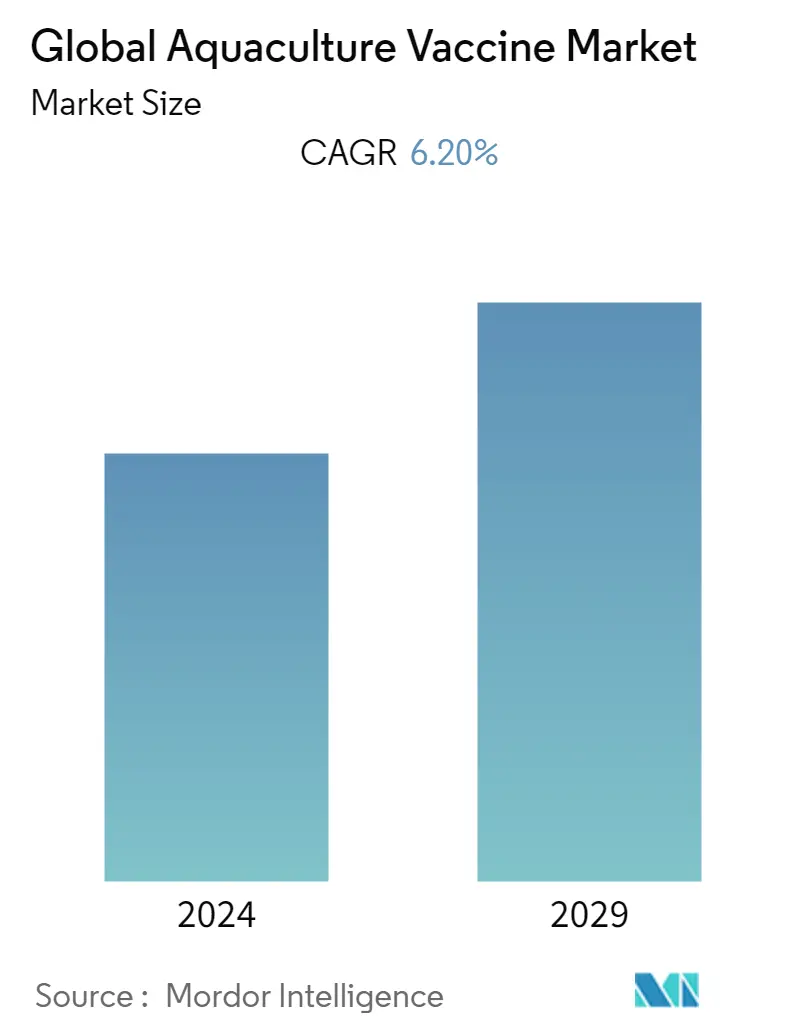Market Size of Global Aquaculture Vaccine Industry

| Study Period | 2019 - 2029 |
| Base Year For Estimation | 2023 |
| CAGR | 6.20 % |
| Fastest Growing Market | North America |
| Largest Market | Asia-Pacific |
| Market Concentration | Medium |
Major Players
*Disclaimer: Major Players sorted in no particular order |
Need a report that reflects how COVID-19 has impacted this market and its growth?
Aquaculture Vaccines Market Analysis
During the time frame of the forecast, the aquaculture vaccines market is expected to register a CAGR of 6.2%. The COVID-19 pandemic had a significant impact on the animal industry, as due to the lockdown there was a significant impact on the logistics and supply chain of not only the essential pharmaceutical products for animals but also feed and other food items for animals, which affected the studied market. According to a Marine Policy research study published in September 2021, the COVID-19 pandemic affected the aquaculture industry in a variety of ways, including disruption in logistics and supply chains, which resulted in increased transportation costs (approximately 20-60% higher than usual), a decrease in market demand for fish, cancellation of orders from foreign buyers, an increase in input and maintenance costs, a labor shortage, and all these, COVID-19 had a significant impact on the aquaculture vaccine market. Also, with the consecutive second and third waves of COVID-19 infections in various countries, the market is set to observe sluggish growth in the short-term period. However, the market is expected to improve gradually and return to pre-pandemic growth levels in the forecast period due to an ease in lockdown restrictions.
The increasing consumption of aquatic animals is propelling the growth of the aquaculture industry, which is expected to be a primary growth factor for the market as aquaculture vaccines reduce the chance of infection and increase the yield of the product, which is expected to fuel growth in the aquaculture vaccines market over the forecast period. For instance, according to the 2022 report of the Food and Agriculture Organization (FAO) of the United Nations, the global production of aquatic animals stood at approximately 178 million tons, and of the total production, 63% (112 million tons) was harvested in marine waters (70% from capture fisheries and 30% from aquaculture) and 37% (66 million tons) in inland waters (83% from aquaculture and 17 percent from capture fisheries). Further, as per the same source, the global consumption of aquatic food is increasing, which is expected to further boost growth in aquaculture production. Consumption has increased from 9 kg in 1961 to 20.2 kg in recent decades, with the factors that have had the greatest impact on per capita consumption of aquatic foods being increasing supplies, shifting consumer preferences, technological developments, and rising incomes.Thus, the growing aquaculture industry is expected to drive the demand for aquaculture vaccines for a greater yield, which is expected to fuel growth in the aquaculture vaccines market over the forecast period.
Other factors that are expected to have a significant impact on the growth of the aquaculture vaccines market include the high prevalence of infectious diseases among aquatic animals and new product developments launched by the players in the market to tackle these diseases. For instance, according to a research study published in February 2022 by Frontiers, the anisakid nematodes were prevalent in fish across China, with a pooled incidence of 45.5%, and the incidence percentage for fresh fish was the greatest (58.1%). Fish from the East China Sea had the highest prevalence of anisakid nematodes (76.8%), while Eastern China had the highest prevalence rate (55.3%). Hence, due to the high prevalence of diseases, the demand for aquaculture vaccines is expected to grow, therefore propelling the market toward growth.
In addition to this, the launch of new aquaculture vaccines on the market is further expected to boost market growth. For instance, in April 2021, the Indian Council of Agriculture Research-Central Institute of Brackishwater Aquaculture (ICAR-CIBA) launched a recombinant vaccine called CIBA-Nodavac-R against viral nervous necrosis (VNN) that affects many marine, brackishwater, and freshwater fish, causing up to 100 percent mortality in larval and early juvenile stages. Similarly, in October 2021, a professor from Sylhet Agriculture University (SAU) in Bangladesh developed an oral vaccine for fish that can protect different species of fish from bacterial diseases and boost their production. The vaccine can be applied to the fish after mixing it with their feed.
Therefore, due to the above-mentioned factors, the aquaculture vaccines market is expected to grow over the forecast period. But strict regulations about vaccines are likely to slow the growth of the studied market over the next five years.
